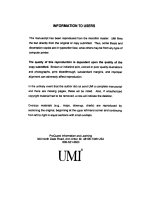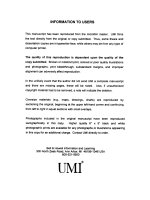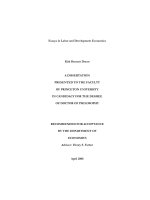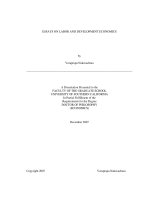Essays on public and development economics
Bạn đang xem bản rút gọn của tài liệu. Xem và tải ngay bản đầy đủ của tài liệu tại đây (2.77 MB, 146 trang )
ABSTRACT
Title of dissertation: ESSAYS ON PUBLIC AND DEVELOPMENT
ECONOMICS
Diether Wolfgang Beuermann, Doctor of Philosophy, 2010
Dissertation directed by: Professor Mark Duggan
Department of Economics
In Chapter 1, we study an intervention in which the Peruvian government
provided public payphones to 6,509 rural villages that did not have communication
services before. We show that the intervention timing was orthogonal to potential
outcomes and exploit it using a panel of treated villages. Findings suggest increases of 16
percent in prices received by farmers for their crops, and a 23.7 percent reduction in
agricultural costs. This income shock has been translated into a reduction in child market
and agricultural work of 13.7 and 9.2 percentage points respectively. Findings are
consistent with a dominant income effect in child labor demand.
In Chapter 2, we exploit a randomized intervention directed towards enhancing
local governments’ efficiency in three regions of rural Russia (Adyghea, Penza and
Perm) at the onset of a major decentralization reform. We find that satisfaction levels
with decentralized services increased only in the region with relatively higher ex-ante
experience with decentralized and participatory decision making (Penza). Moreover, we
find that settlements with high pre-treatment accountability levels were differentially
benefited by the intervention. Our findings suggest that short-term interventions do not
translate into higher satisfaction with local public services. Rather, it appears that
enhancing local managerial efficiency in delivering public services is a long-term process
and that intensive interventions translate into higher satisfaction provided to local
governments with relatively longer institutional experience and higher levels of
accountability.
In Chapter 3, we use the timing of cell phone coverage in Peru as an exogenous
shock to investigate the effects of phone coverage on several measures of economic
development. We exploit a unique dataset drawn from information of private cell phone
operators regarding the location, date of installation and technical characteristics of their
towers from 2001 through 2007. We then merge this information with national household
surveys spanning the same period. Estimates suggest an increase of 7 percentage points in
the likelihood of self reported cell phone ownership after getting coverage, an increase of
7.5 percent in yearly household expenditures after coverage, and a 13.5 percent increase
in the value of assets.
by
Diether Wolfgang Beuermann
Dissertation submitted to the faculty of the Graduate School of the
University of Maryland, College Park in partial fulfillment
of the requirements for the degree of
Doctor of Philosophy
2010
Advisory Committee:
Professor Mark Duggan, Chair
Professor Christopher McKelvey
Professor Melissa S. Kearney
Professor Raymond Guiteras
UMI Number:
3443424
All rights reserved
INFORMATION T
O ALL USERS
The quality of this reproduction is dependent upon the quality of the copy submitted.
In the unlikely event that the author did not send a complete manuscript
and there are missing pages, these will be noted. Also, if material had to be removed,
a note will indicate the deletion.
UMI
3443424
Copyright 2
011 by ProQuest LLC.
All rights reserved. This edition of the work is protected against
unauthorized copying under Title 17, United States Code.
ProQuest LLC
789 East Eisenhower Parkway
P.O. Box 1346
Ann Arbor, MI 48106-1346
© Copyright by
Diether Wolfgang Beuermann
2010
TABLE OF CONTENTS
Table of Contents ii
List of Tables iv
List of Figures v
Chapter 1: Telecommunications Technologies, Agricultural Profitability,
and Child Labor in Rural Peru 1
Introduction 1
The FITEL Program 6
Village Selection Criteria 7
Intervention Timing 8
Expected Outcomes 9
Effects on Prices 11
Effects on Child Labor 13
The Data 15
Empirical Strategy 21
Results and Discussion 24
Agricultural Outcomes 24
Child Labor Effects 27
Heterogeneous Effects in Utilization of Child Labor 30
Sensitivity Analysis 34
The Relation Between Profitability and Child Labor 37
Robustness Analysis 39
Falsification Test 39
Survey Design Issues 40
Spillover Effects 41
Event Studies 42
Summary and Conclusions 46
Chapter 2: The Role of Local Governments’ Efficiency in Decentralized Public
Service Delivery: Evidence from a Randomized Intervention in Rural
Russia 48
Introduction 48
Decentralization in Rural Russia 52
First Stage 52
Second Stage 53
The Intervention 56
Intervention Description 57
Theoretical Predictions 59
Evaluation: Data Collection and Empirical Approach 65
Data Collection 65
Empirical Approach 70
Intervention Results 73
The Process of Formal Public Decision Making 73
iii
Outcomes of Formal Public Decision Making 81
Heterogeneous Treatment Effects 89
Estimated Impacts and Citizens’ Priorities 96
Identifying the Mechanisms behind the Results 98
Was Treatment Assignment Revenue Neutral? 98
Was Increased Efficiency the Mechanism Driving our Results? 102
Conclusions 105
Chapter 3: The Effects of Mobile Phone Infrastructure: Evidence
from Rural Peru 108
Introduction 108
Theory and Literature Review 112
Data and Context 114
Methodology 118
Results 121
Baseline Specification 121
Village Fixed Effects 122
Duration of Treatment 122
Home Farm and Business Income 124
Robustness Check: Migration 127
Heterogeneous Effects: Mobile Phone Ownership 128
Conclusions 129
Bibliography 131
iv
LIST OF TABLES
Chapter 1: Table 1: Timing of FITEL Intervention 9
Table 2: Household sample size by survey year and treatment timing 16
Table 3: Children sample size by survey year and treatment timing 17
Table 4: Village sample size by survey year and treatment timing 17
Table 5: Summary statistics at baseline (1997 – 2000) 19
Table 6: Baseline differences for agricultural households 23
Table 7: Baseline differences for children between 6 and 13 years old 23
Table 8: Estimated effects on agricultural outcomes 25
Table 9: Estimated effects on children’s outcomes 28
Table 10: Child labor by gender and age 31
Table 11: Estimated effects by parental education 33
Table 12: Child labor sensitivity analysis 35
Table 13: Effects of profitability on child labor 38
Table 14: Falsification test 40
Table 15: Estimated effects dropping years 1997 and 2000 41
Table 16: Spillover effects 42
Chapter 2: Table 1: Functions assigned to settlements 55
Table 2: Functions assigned to districts 55
Table 3: Fiscasl shares 56
Table 4: Settlements distribution by treatment status 59
Table 5: Attrition patterns acrosss regions 67
Table 6: Relation between treatment and attrition 68
Table 7: Attrition check – Penza region 69
Table 8: Estimated treatment effects – Penza region 74
Table 9: Estimated treatment effects – Adyghea region 79
Table 10: Estimated treatment effects – Perm region 80
Table 11: Heterogenous treatment effects - accountability 92
Table 12: Estimated impacts and citizen’s priorities – Penza region 97
Table 13: Estimated impacts and citizen’s priorities – Adyghea region 98
Table 14: Estimated impacts and citizen’s priorities – Perm region 98
Table 15: Revenues and expenditures trends 100
Table 16: Expenditures in public services and satisfaction 104
Chapter 3: Table 1: Comparing covered and uncovered households 119
Table 2: Regression models 121
Table 3: Regression models with village fixed effects 122
Table 4: Duration of coverage regression models with village fixed effects 123
Table 5: Home farm outcomes 125
Table 6: Home business outcomes 126
Table 7: Robustness check - migration 127
Table 8: Heterogeneous effects – mobile phone ownership 129
v
LIST OF FIGURES
Chapter 1: Figure 1: Intervened villages by treatment timing 4
Figure 2: FITEL Program 9
Figure 3: Sampled villages by treatment timing 18
Figure 4: Child market work at baseline (1997 – 2000) 20
Figure 5: Child agricultural work at baseline (1997 – 2000) 20
Figure 6: Child wage work at baseline (1997 – 2000) 21
Figure 7: Value per kilogram sold 43
Figure 8: Agricultural profitability 44
Figure 9: Child market work 45
Figure 10: Child agricultural work 45
Chapter 2: Figure 1: Structure of local Self-Government in Russia 53
Figure 2: Geographical Location of Intervened Regions 59
Chapter 3: Figure 1: Mobile phones subscriptions and fixedlines per 100 inhabitants,
1997 - 2007 109
Figure 2: Map of mobile towers, 2001 115
Figure 3: Map of mobile towers, 2007 116
1
Chapter 1: Telecommunications Technologies, Agricultural Profitability, and Child
Labor in Rural Peru
1) Introduction
Economic theory emphasizes the importance of information for the efficiency of
markets (Stigler, 1961; Brown and Goolsbee, 2002). Accordingly, reductions in
information search costs are expected to enhance market effectiveness. Recent advances
in telecommunication technologies (TC) have made information transmission extremely
cheap in developed societies. However, in the context of isolated communities in
developing countries, TC are still far from being universally available. Therefore,
interventions providing new access to TC in such societies provide an ideal opportunity
to assess the impact of improved information accessibility on market performance.
Furthermore, if market effectiveness is improved with new TC, it becomes interesting to
assess how this improved market performance influences household decisions such as the
utilization of child labor and schooling. Accordingly, the purpose of this paper is to shed
light on how the introduction of payphones among rural villages in Peru affected
agricultural profitability and the utilization child labor.
Previous literature has studied the effects of TC using the introduction of cell
phones as exogenous shocks. For example, Jensen (2007) analyzed the impact of cell
phones introduction among fishermen in the Indian state of Kerala. The results show that
the adoption of mobile phones was associated with a dramatic reduction in price
dispersion, the complete elimination of waste, and near-perfect adherence to the law of
one price. The mechanism behind such results is that fishermen started using the cell
phones to gather information regarding markets with better prices (in short supply) while
2
in the sea. Therefore, they started to go directly towards these markets to sell their catch
and, as a result, prices were equated across markets and market clearing resulted in
eliminating the waste coming from unsold fish that was common before cell phone
availability.
In the same vein, Aker (2010) analyses the effects of cell phone introduction in
Niger. She focuses on grain markets and suggests that cell phones reduced price
dispersion across markets by 6.4 percent and intra-annual price variation by 12 percent.
Furthermore, the study finds greater impacts in market pairs that are farther away and for
those with lower road quality. The study suggests that the main mechanism by which cell
phones generate these outcomes is a reduction in search costs. Traders who operate in
markets with cell phone coverage search over a greater number of markets and sell in
more markets, thereby reducing price dispersion.
Recently, Goyal (2010) provides evidence regarding the effects of internet kiosks
placement among rural districts in the Indian state of Madhya Pradesh. These kiosks
provided real time information of soybean market prices to farmers. The study shows that
the kiosks caused an increase of 1.7 percent in the monthly mode price of soy. This result
supports the theoretical prediction that the availability of price information to farmers
increases the competitiveness of traders in local output markets, leading to an increase in
the price of soybean in the intervened districts.
It is worth noting that the intervention studied here differs from the previous
studies in that it involves public (satellite) payphones rather than cell phones or internet
kiosks. This intervention occurred in places where neither cell phones nor fixed line
phones were available. The treated villages were located in zones where cell phone
3
coverage was technically and economically unfeasible. The satellite technology
implemented did not require villages to posses fixed lines or electrical supply in order to
enjoy the service. Therefore, phone placement only followed the criteria of being
provided to villages without prior access to TC. This coupled with differences in timing
for phone placement that were uncorrelated with baseline characteristics, allows us to
circumvent concerns common to previous studies regarding endogenous placement of TC
with respect to the outcomes of interest.
1
The specific intervention was carried out by the Peruvian Fund for Investments in
Telecommunications (FITEL), which provided at least one public (satellite) payphone,
mostly between years 2001 and 2004, to each of the 6,509 targeted villages situated
across rural Peru (See Figure 1). None of these villages had any kind of phone services
(either fixed lines or cell coverage) prior to the intervention, so these payphones were the
first opportunity for villagers to communicate with the rest of the country without having
to physically travel or use the mail. According to FITEL’s documents, the intervention
reduced the average distance from any rural village in Peru to the nearest communication
point from 60km. to 5km.
2
I exploit differences in the timing of the intervention across
villages to identify the impacts of payphones on agricultural profitability and the
utilization of child labor, after showing that these differences in timing were orthogonal
to changes in potential outcomes.
1
This concern comes from the fact that previous studies have exploited differences in the timing of cell
phone coverage across markets as if such differences were as good as random. However, cell phone
coverage is a decision of private companies and some concern arises from the fact that these companies
may first cover zones with higher economic development potential. By contrast, the intervention to be
studied was performed only in disadvantaged villages, and below we show that the timing of it was
orthogonal to potential outcomes and other variables that might be systematically related to them.
2
This refers to the whole country in aggregate, not only an average across treated villages.
4
Figure 1: Intervened villages by treatment timing
Previous studies regarding the economic effects of TC concentrate on market
outcomes, with a specific focus on price dispersion and market performance. However,
none directly address effects of new TC on producers’ profitability and how this
potentially increased profitability may affect intra-household decisions regarding the
utilization of child labor which is very common in rural Peru. This paper, therefore,
contributes with new evidence regarding the effects of TC not only on market outcomes
such as agricultural profitability but also on intra-household decisions. If TC affects
agricultural profitability, the effects on child labor utilization are ambiguous. On the one
hand, the substitution effect implies that the opportunity cost of time for a child that is not
working becomes higher. Therefore, this effect suggests an increased utilization of child
5
labor. However, on the other hand, an increased income enjoyed by the household
suggests that the utilization of child labor will decrease and, therefore, the child will
devote more time to activities representing normal goods for the household (such as
leisure or schooling).
In sum, the total impact on child labor will be the net outcome of offsetting
income and substitution effects. For instance, the international literature, using different
sources of household income variation, has found mixed effects. Some studies find a
dominant substitution effect (Duryea and Arends-Kuenning, 2003; Kruger, 2006; and
Kruger, 2007). While others suggest a dominant income effect (Beegle et. al., 2006;
Dehejia and Gatti, 2005; Dammert, 2008; Del Carpio, 2008; Del Carpio and Marcours,
2009). This paper is the first that uses variation arising from the introduction of TC to
identify the impacts of agricultural profitability on child labor.
The main findings suggest that the intervention generated increases of 16 percent
in the value perceived for each kilogram of agricultural production, and a 23.7 percent
reduction in agricultural costs. This led to an increase of 19.5 percent in agricultural
profitability (measured by the financial return to agricultural activities). Moreover, this
income shock translated into a reduction in the incidence of child (6 – 13 years old)
market work equivalent to 13.7 percentage points and a reduction in child agricultural
work of 9.2 percentage points. Overall, the evidence suggests a dominant income effect
in the utilization of child labor.
The rest of the paper is organized as follows. Section 2 presents a description of
the FITEL program. Section 3 presents an analytical framework to understand the
expected outcomes of the intervention. Section 4 presents the dataset used for the
6
empirical analysis. Section 5 describes the empirical approach adopted in the analysis.
Section 6 discusses our main results, while section 7 checks the robustness of these
results. Finally, section 8 concludes.
2) The FITEL Program
In 1992, the Peruvian government privatized all state-owned telecommunications
companies and created a Telecommunications Regulatory Authority (OSIPTEL).
3
In May
1993, OSIPTEL created the Fund for Investments in Telecommunications (FITEL) which
began to collect a 1% levy charged on gross operating revenues of telecommunications
companies in order to fund rural service expansion. In November 2006, FITEL was
declared an individual public entity ascribed to the Ministry of Transports and
Communications.
The specific FITEL intervention studied here provided at least one public
(satellite) payphone to each of the 6,509 targeted villages. To do so, FITEL divided the
country into seven geographical regions (i.e. north border, north, middle north, middle
east, south, middle south, and north tropical forest). The project was executed by granting
a 20-year concession to private operators for public telephone services in each
geographical region. The selection of the operator for each region was based on an
international auction for the lowest subsidy requested from FITEL for the installation,
operation and maintenance of these public services. It is worth noting that all phones,
regardless of which operator wins each region, had to be homogeneous with respect to
the technology (i.e. satellite vsat phones). Targeted villages were selected by FITEL prior
to the auctioning process following the three-phase procedure described below.
3
Prior to 1992 the telecommunications sector was state-owned and no private firms existed.
7
2.1. Village Selection Criteria
The selection of the rural villages to benefit from the project was based on the
criteria of maximizing the social profitability of the public investment, while minimizing
the subsidy. The selection process was composed of three phases, as follows:
a) Phase I: In this phase, FITEL defined the target universe of villages for the
intervention. The universe was composed of rural villages with populations between 200
and 3,000 inhabitants that did not have access to TC. Furthermore, villages in the targeted
universe could not be in any future coverage plan of private telecommunications
companies. Therefore, targeted villages neither had nor expected to be provided access to
TC.
b) Phase II: Villages in the target universe were grouped in cells with average radius of
5km. Cells were formed with the requirement that no village within the cell could either
have phone service or be included in the expansion plan of a private operator. Then, one
village within each cell (cell center) was pre-selected for treatment (i.e. payphone
installation). To be selected as a cell center, the village needed to comply with at least
one of the following requirements: (i) have a health center; (ii) be accessible (i.e. in
connection with rural roads, river crosses or horse paths); (iii) have a high school; and
(iv) have the highest population within the cell or be a central village in the sense that
villagers in the cell confluence to that village to market products or get health services. In
addition, district capitals without phone services and that were not included in future
expansion plans of private operators were automatically selected as cell centers.
8
c) Phase III: This phase consisted of field visits to all of the cell centers. The purpose of
this field work was to assess the technical viability of installing payphones. In addition,
several workshops were conducted in district capitals that were selected as cell centers.
These workshops encouraged the participation of district leaders and representatives of
local civil society. The purpose of these workshops was to assess the convenience of the
selected cell centers. After this field work, the list of pre-selected villages was updated
and the final list of targeted villages was selected.
The outlined selection criteria suggest that targeted villages in the different
geographical regions of the intervention were similar with respect to several development
characteristics. Therefore, the empirical strategy will exploit differences in the timing of
the intervention across villages in order to identify causal impacts. This timing is briefly
explained below.
2.2. Intervention Timing
Once targeted villages were selected, FITEL auctioned 20-year concessions for
each one of the seven geographical zones: north border, north, middle north, middle east,
south, middle south, and north tropical forest. Initially, FITEL planned that all payphones
would be operative by the first quarter of 2002. However, delays in the auctioning
process determined that the program rollout lasted until year 2004. This timing is detailed
in Table 1 and spanned from 1999 through 2004. Provided that the timing of the
intervention was not systematically related with the outcomes of interest and/or with
variables determining these outcomes; the causal impacts can be identified by exploiting
such time variation in phone rollout.
9
Table 1: Timing of FITEL intervention
Year of Treatment Number of Treated Villages Percent Cummulative
1999 213 3.27 3.27
2001 1,184 18.19 21.46
2002 2,666 40.96 62.42
2003 2,368 36.38 98.80
2004 78 1.20 100.00
Total 6,509
Accordingly, the identification strategy will exploit differences in the intervention
timing at the village level, which as we will show below was orthogonal to baseline
outcomes and to variables plausibly related to them. In the empirical analysis, however,
we exclude villages treated in 1999 (north border project). These because the 213 villages
treated in 1999 were treated first for potentially endogenous reasons, due to their
importance as a border with Ecuador (this region is highlighted in Figure 2).
4
Figure 2: FITEL Program
3) Expected Outcomes
The mechanisms through which access to TC may impact agricultural profitability
are diverse. First, the presence of TC greatly decreases the costs associated with
4
However, results remain qualitatively the same, when these villages are included.
10
searching for information across different markets in order to sell (buy) agricultural
production (inputs) in places offering the best prices. Second, by allowing farmers to be
informed about the real market price of their crops, TC increases farmers’ bargaining
power with traders approaching their villages to buy their production. Third, access to TC
may allow farmers to be informed about weather forecasts and incorporate this
knowledge into their planting decisions. This could improve efficiency, for example, less
fertilizer may be necessary if better weather information allows farmers to plant at a more
optimal time.
The previous mechanisms may coexist, of course, and the aggregate effect reflects
all of them. However, a half program survey conducted by FITEL in 2002 among villages
that already had a phone reveals that 19.5 percent of treated households use the
technology to search for market information. This is the second most important reason for
using the phone (the first was social/family communication, at 95.3 percent).
Furthermore, when looking only at households engaged in agricultural production, 38
percent report searching market information as the main usage. In addition, 70 percent of
households who report using the phone for market information search reveal that the
frequency of these searches is either weekly or daily. This evidence suggests that the
main mechanism through which the new technologies affected agricultural profitability is
likely a reduction in search costs. We now present a simple model that formalizes this
mechanism.
11
3.1. Effects on Prices
We assume that farmers derive utility from their agricultural activity through a
Bernoulli utility function defined over output and input prices (net of transport costs) as
follows:
(
)
(
)
(
)
,
oi o i
uPP vP gP=− (1)
where
o
P denotes output prices,
i
P denotes input prices and '0,''0,vv>≤and ' 0g > .
In addition, we assume a constant marginal cost C of searching for price
information in an additional market. Therefore, if a farmer has already searched for prices
in N markets, with O being the best offered price for his output and I the best price found
for his input, the expected marginal utility of the N+1 search is given by:
()
[][]
, ()() ()() ()()
o
i
P
I
oi io
oP
B
OI vP gP vO gI dGPdFP C
⎡⎤
=−−− −
⎢⎥
⎢⎥
⎣⎦
∫∫
(2)
where
o
P and
i
P represent the maximum possible output price and minimum possible
input price respectively. (.)
F and (.)G are the CDFs of output and input prices
respectively. Notice that (2) assumes that if the utility derived from prices found in the
N+1 search is below the reservation utility (derived from prices
O and I), then the farmer
will sell his output at price
O and buy his input at price I.
5
So, in that case, the benefit of
the N+1 search will be actually a cost of
C. This depends on the probabilities of getting
better prices. All else equal, as these probabilities fall, will be less attractive to search in
another market. Therefore, optimality implies (assuming an interior solution) that the
farmer will set his reservation price for output (
R) and maximum price paid for the input
(
M) by equating the expected marginal benefit of the N+1 search to zero. Therefore, the
5
Notice that this assumes that outputs are sold and inputs purchased in the same market.
12
reservation price for output and maximum price for the input will be implicitly defined
by:
()
[][]
, ()() ()() ()() 0
o
i
P
M
oi io
RP
BRM vP gP vR gM dGPdFP C
⎡⎤
=−−− −=
⎢⎥
⎢⎥
⎣⎦
∫∫
(3)
The effect of a change in
C on R can be derived from (3) using the implicit
function theorem and Leibnitz’ rule as follows:
[]
()
(, )
(, )
1
0
( ) '( ) 1 ( ) '( ) ( ) ( ) |
ii
BRM
R
C
BRM
C
R
GMv R FR F R gM E gP P M
∂
∂
∂
=− =
∂
∂
∂
<
−−−−≤⎡⎤
⎣⎦
(4)
Similarly, the effect of a change in C on M can be derived from (3) as follows:
()
[]
(, )
(, )
1
0
'() ()| () 1 () '()()
oo
BRM
M
C
BRM
C
M
GM EvP P R vR FR gMGM
∂
∂
∂
=− =
∂
∂
∂
>
≥− +−⎡⎤
⎣⎦
(5)
Clearly, (4)-(5) imply that reservation prices should rise and maximum prices paid
for inputs should fall if search costs decrease. The introduction of TC dramatically
reduced search costs. In particular, the intervention reduced average distance to the
nearest communication point from 60 km. to 5 km. nationwide. Thus, we expect that
average reservation prices will rise (prices paid for inputs will fall) and therefore
agricultural profitability will rise following the installation of payphones.
13
3.2. Effects on Child Labor
In the context of rural villages, child labor in farms is very common. Parents
decide how to allocate their children’s time between school and work. An increase
(decrease) in the prices that farmers get for their outputs (pay for their inputs) implicitly
raises the opportunity cost of schooling. This happens because an additional unit of labor
provided to the farm is more valuable when per unit profits are higher. Therefore, the
substitution effect implies that an increased opportunity cost of schooling will generate a
reduction in its demand and, consequently, an increase in the utilization of child labor.
On the other hand, an increase in per unit profits raises household income and,
assuming that schooling is a normal good while child labor an inferior one, the income
effect implies that demand for schooling will increase and utilization of child labor will
decrease. As a result, the introduction of TC generates offsetting substitution and income
effects on child labor. The income effect suggests that a reduction in search costs will
decrease child labor, while the substitution effect suggests the opposite. Therefore, the
total effect of the introduction of TC on the utilization of child labor is ambiguous.
To formalize the argument, consider a household where the father decides how
much time a child will dedicate to school, S, and to work in the farm, F.
6
There is an
increasing and concave human capital production function which depends on S, HK(S).
Parents derive utility from current consumption,
c
C , and human capital of the child.
Therefore, parents’ utility is given by:
[
]
,()
c
UC HKS (6)
6
I assume that working in the farm is not an activity that provides human capital to the child.









